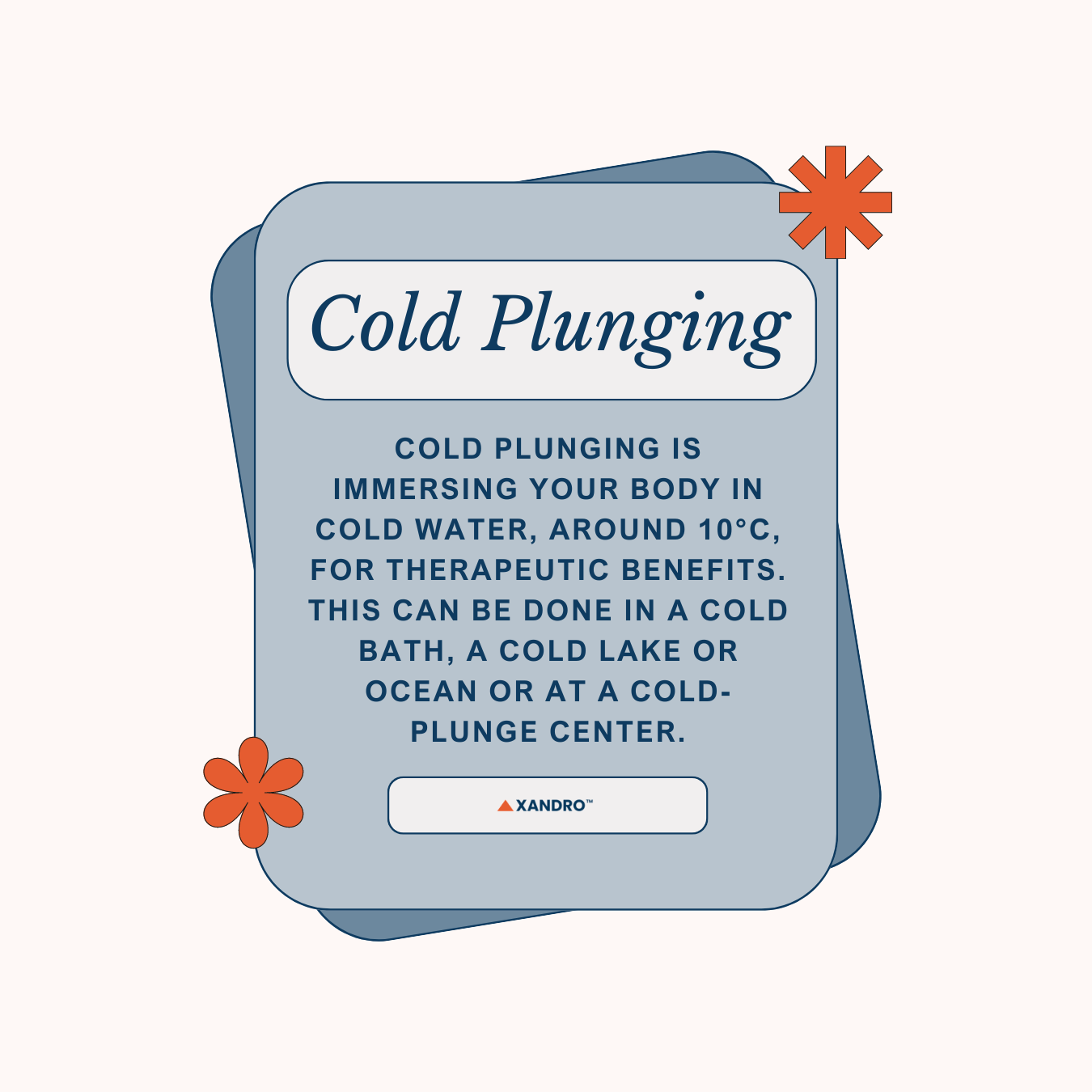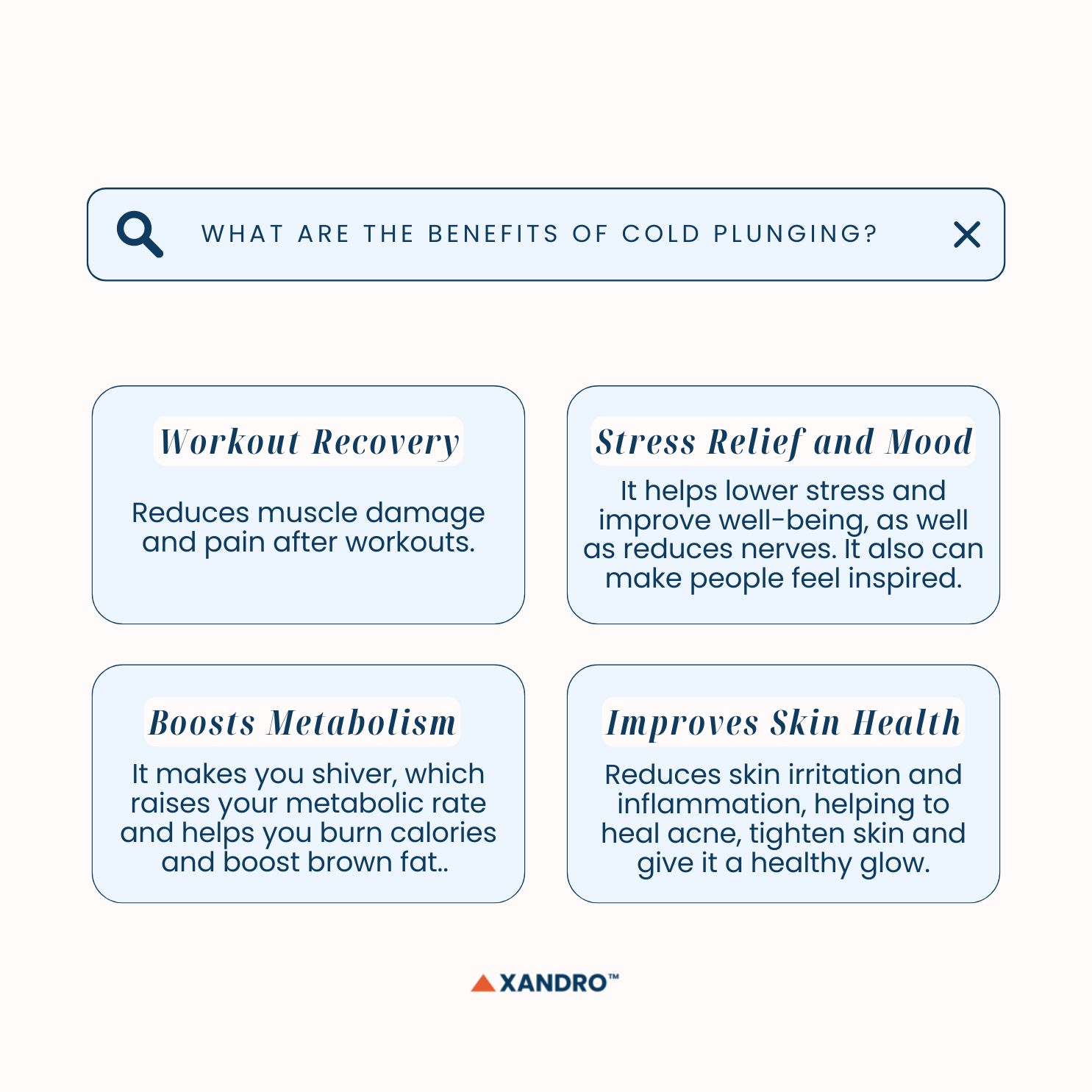Discover the Benefits of Cold Plunging in Singapore
10th Aug 2024
All About Cold Plunging + Where to Cold Plunge in Singapore
Athletes do it and now many longevity experts are taking up the practice, but what exactly is cold plunging and what are cold plunge benefits?
This article will cover all you need to know about cold plunging, so jump there now:
- What Is Cold Plunging?
- Is Cold Plunging Really Good for You?
- How To Cold Plunge Properly?
- What Not to Do After a Cold Plunge?
- Where To Find a Cold Plunge Pool Singapore
A cold plunge, meaning someone immersing their body in cold water, is a form of cryotherapy that has a range of benefits.
It can be as simple as filling your bathtub with cold water and ice cubes, taking a dip in a cold lake or ocean or visiting a cold-plunge centre.
A cold plunge temperature generally sits at around 10oC if you’re doing it at home, although water in frozen lakes will be much colder, so make sure to check the temperature before you jump in.
What about a cold plunge vs cold shower? A cold shower is more accessible to people since you don’t need to spend extra money and you can do it at home, however, it’s difficult to accurately control the temperature of the shower, making it hard to build your resilience to the cold. Plus, in the summer months, sometimes showers cannot reach the beneficial cold range.
This differs from a cold plunge where you can completely cover your entire body to experience a greater response, with whole body immersion improving stress relief and fat body benefits, but more on that below.

Let’s go over some cold plunge benefits:
Helps You Recover from Workouts
Many athletes and exercise enthusiasts turn to cold plunging to help them in their recovery after intense workouts, competitions or HIIT exercises.
There are even scientific benefits of cold plunge for workout recovery. It was found to be effective for lowering muscle damage and delaying the onset of muscle soreness after high-intensity exercise compared to those who did passive forms of recovery.
Helps You Relieve Stress and Boost Your Mood
Studies have shown that bathing or swimming in cold water is linked with low stress levels and higher overall well-being, along with the individual having a better understanding of their health and wellness needs.
Studies have even shown that those who soak in 20oC water for five minutes feel more alert and inspired afterwards, as well as feel less stressed and nervous.
Reduces Your Pain and Inflammation
Once in the cold water, your internal body temperature drops and as your body heat drops, this causes changes in your blood flow. These changes, such as restricting your blood vessels, reduce blood flow to the areas in your body where there’s inflammation, which is believed to help reduce the inflammation, reduce sore muscle, help with workout recovery and even boost immunity.
It's been found to reduce pain in those with gout arthritis as well as improve joint mobility and impact their perception of pain, helping improve their overall quality of life.
Helps Boost Metabolism
When we’re cold, we shiver, and shivering has been found to generate extra body heat as well as raise metabolic rate. This rise helps you burn more calories when resting. Cold therapy is also a way to boost brown fat as when we’re cold, blood flows to this brown adipose tissue, which keeps you warm and burns calories. Hence, it’s thought that regular cold plunging may help you lose weight.
Further Reading: How to Boost Metabolism
Cold plunging may also help you regulate your blood sugar and improve your insulin sensitivity.
Improves Heart Health
Some research has shown that cold plunges or cold water therapy may improve blood flow, reduce one’s heart rate and improve cardiovascular health.
Helps the Immune System
Cold showering and cold plunging may also improve the immune system, as research has shown that it results in fewer sick days in participants.
Improved Skin Health
So, is cold plunging good for your skin? Since it can help reduce inflammation, this can improve collagen, which inflammation can damage. Since the cold restricts blood vessels, this also calms inflamed and irritated skin, helping to heal acne. In this way, cold plunging can also improve blood flow to your skin, making it look healthier, plus, it can tighten the skin by contracting pores. While it doesn’t do this permanently, it can help make the skin look smoother and give it a healthy glow.

Further Reading: Brown Fat vs White Fat
As you can see, there are benefits of cold plunging every day, but most people only do it once or a few days a week. If you’re doing it for performance purposes, keep in mind that this could compromise potential long-term performance improvements if doing it each day.
Before putting your body through anything extreme, like cold plunging, be sure to speak with your doctor as it’s not for everyone due to cold plunge risks, as people have died.
This is thought to be from rapid incapacitation rather than from hypothermia. There is also a chance of experiencing cold shock, where you are suddenly immersed in extremely cold water and you struggle to breathe or you get sudden heart and blood pressure issues or impaired mental abilities. Cold shock can cause people to gasp, hyperventilate, feel breathless or feel as though they’re suffocating. This can cause people to lose control of their arms and legs, making them become exhausted and have muscle fatigue, causing them to drown.
The elderly are advised not to cold plunge as it may even cause heart arrhythmias and lead to muscle damage if in the cold water for too long.
Also, speak with your doctor about how often you should do a cold plunge as well as the best time of day.
So, here are some steps to do a cold plunge:
- Start slow and listen to your body, giving yourself time to adjust to the shock of the cold water. Start by taking cool showers and adjusting the temperature to help you prepare.
- If it’s below 20oC, stick to an indoor cold plunge pool as this can be dangerous if done outdoors, especially if you’re not used to it.
- Make sure you’re doing a cold plunge with someone else, especially your first time.
- Slowly drop your body into the water, keeping your head above the water.
- As for how long to stay in cold plunge, try not to stay in the water for longer than five minutes. You can build up your tolerance gradually. Start with 30 seconds, building this up to a minute then up to five and then ten. There is no optimal time or process for cold plunges.
Some people feel unwell and shiver excessively after a cold plunge, commonly known as the after-drop. Like when if you put your cold fingers and toes in hot water you can get chilblains, if your body gets warm too quickly after being exposed to the cold, your blood vessels can dilate too quickly and cause a sudden drop in your core body temperature.
If your body is telling you to get out, get out, as your cold tolerance needs to build up over time. Once out of the water, pat yourself dry and move your body around by walking or doing light exercises for the same amount of time you were in the water, allowing yourself to gradually warm up. Do not suddenly expose yourself to warm environments or cover yourself in layers of clothing.
Looking for a ‘cold plunge near me?’
You might think it’s difficult to find somewhere cold enough to do a cold plunge in Singapore but don’t worry, there are plenty of venues around the city offering ice-cold waters! Some are private, others are guided and you can usually purchase single-session or multi-session packs for your convenience.
Here are a few to check out in Singapore:
- Trapeze Rec Club
- Cold Plunge SG
- Level Up
- Care Collective
- Athletic Chamber
- Sphere
- Sama Haus
- Rekoop
- Wim Hof Method Singapore
- Ice Bath Club
- Athletic Collective
End Note
While more scientific studies on cold plunging are needed, the initial benefits and anecdotal evidence are promising. Start with cold showers then, if not in Singapore, check out cold plunge venues in your city to start building up your tolerance, even if it’s just after intense workouts.
You can learn more about metabolism and weight loss practices in our blogs or try out our range of dietary supplements to help with your health goals.
To help with your weight loss journey, why not try out our latest supplement, Lean XP, to help you burn off fat?
